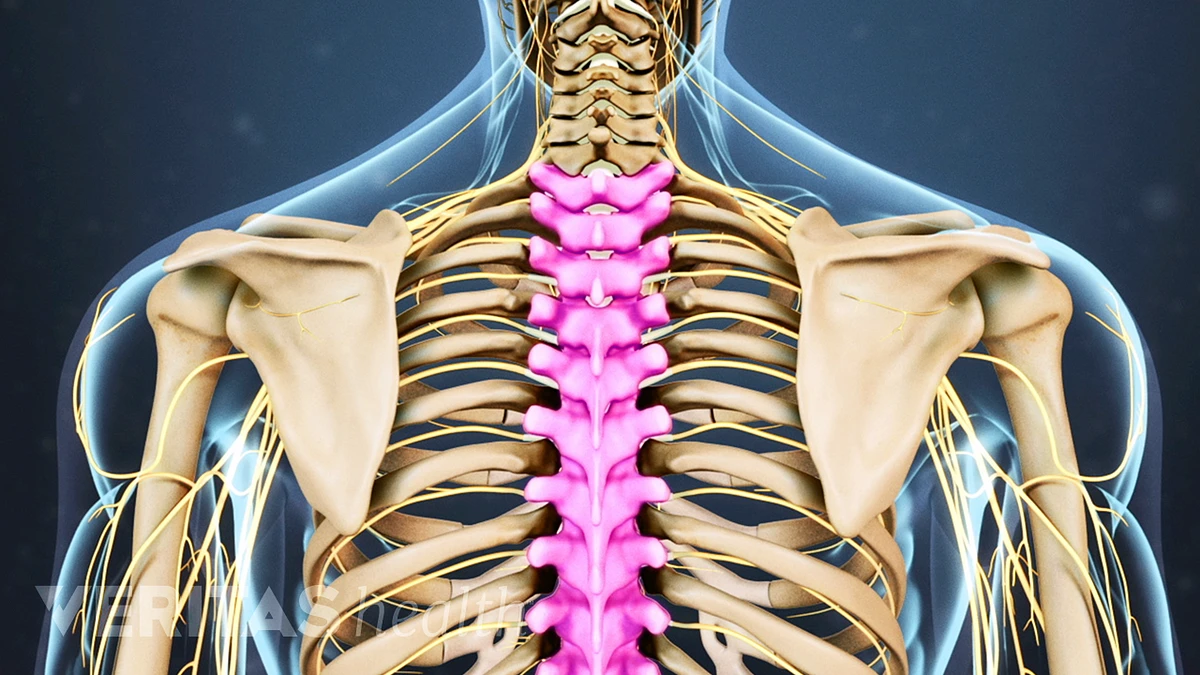Back
The Thoracic Spine and Pelvic Floor Connection -- Why Do We Care About the Mid-back?
By Dr. Christine Martirez PT, DPT on 5/23/2024

The Thoracic Spine and Its Impact on the Pelvic Floor
The thoracic spine, a key component of our spinal column, plays a crucial role in maintaining proper posture and overall spinal health. Its impact extends beyond the back and shoulders, influencing the pelvic floor muscles and the function of various organs. In this blog post, we will explore how the thoracic spine affects the pelvic floor, the relationship between posture and pelvic floor muscles, and how issues such as diastasis recti and pelvic organ prolapse can be impacted by these connections. Additionally, we’ll discuss how pelvic floor physical therapy can provide effective solutions.
The Thoracic Spine and Pelvic Floor Connection
The thoracic spine (T1-T12) serves as a central structural and functional unit in our body. Here's how it connects to pelvic floor health:
Sympathetic Innervation:
Sympathetic nerve fibers that innervate the bladder originate from the thoracolumbar region, specifically T10-L2. This sympathetic innervation regulates bladder storage by relaxing the detrusor muscle and contracting the internal urethral sphincter. Dysfunction or misalignment in the thoracic spine can disrupt these signals, potentially contributing to urinary issues.Posture and Pelvic Floor Muscles:
Posture, heavily influenced by the alignment of the thoracic spine, directly affects the pelvic floor muscles. Poor posture, such as slouching or excessive forward head posture, can lead to imbalances in muscle tension and coordination. This, in turn, can weaken and/or tension the pelvic floor muscles, leading to problems such as urinary incontinence and pelvic pain.Intra-Thoracic and Intra-Abdominal Pressure:
Increased intra-thoracic pressure, often a result of poor breathing patterns or heavy lifting, translates to increased intra-abdominal pressure. This heightened pressure can exacerbate conditions like diastasis recti (separation of the abdominal muscles) and pelvic organ prolapse (descent of pelvic organs). The diaphragm and pelvic floor work in unison to regulate this pressure, so dysfunction in one area can adversely impact the other.
The Impact of Posture on the Pelvic Floor
Good posture ensures that the spine and pelvis are aligned properly, allowing the pelvic floor muscles to function optimally. Conversely, poor posture can lead to several issues
Muscle Imbalance:
Chronic slouching or excessive curvature of the spine can cause some muscles to become overactive while others weaken. This imbalance often includes the pelvic floor muscles, which may become overstretched or overly tense.Pelvic Floor Dysfunction:
Misalignment of the thoracic spine can affect the entire kinetic chain, leading to pelvic floor dysfunction. Symptoms might include pelvic pain, incontinence, and sexual dysfunction.Breathing Patterns:
Poor posture can impair diaphragmatic breathing, leading to increased reliance on chest breathing. This can elevate intra-thoracic pressure, which in turn increases intra-abdominal pressure, putting additional strain on the pelvic floor.
How Pelvic Floor Physical Therapy Can Help
Pelvic floor physical therapy addresses the multifaceted nature of these issues through various techniques and interventions:
Postural Re-education:
Therapists assess and correct postural imbalances that contribute to pelvic floor dysfunction. Proper alignment of the thoracic spine and pelvis is emphasized to support optimal muscle function.Breathing Techniques:
Teaching proper diaphragmatic breathing can help manage intra-thoracic and intra-abdominal pressures, reducing strain on the pelvic floor.Strengthening Exercises:
Targeted exercises strengthen the pelvic floor, core, and supportive muscles to enhance stability and function.Manual Therapy:
Hands-on techniques such as myofascial release and joint mobilization can improve mobility and reduce pain in the thoracic and pelvic regions.Education and Lifestyle Modifications:
Guidance on body mechanics, safe lifting techniques, and ergonomic adjustments help prevent exacerbation of pelvic floor issues.Neuromuscular Re-education:
Techniques such as biofeedback and pelvic floor muscle training help individuals learn proper muscle activation and relaxation.
The thoracic spine's influence on the pelvic floor highlights the interconnectedness of our body's systems. Poor posture, increased intra-thoracic pressure, and dysfunctional sympathetic innervation from the T10-L2 region can significantly impact pelvic floor health. Pelvic floor physical therapy offers a holistic way to address deficits coming from the thoracic spine and impacting the pelvic floor. Experiencing pelvic floor issues? Reach out to us at Pelvic Health Center in Madison, NJ to set up an evaluation and treatment! Feel free to call us at 908-443-9880 or email us at receptionmadison@pelvichealthnj.com.
Read More:
How Visceral Mobilization Can Assist with the Treatment of SIBO By Dr. Christine Martirez PT, DPT on 10/22/2024 Learn about SIBO and how visceral mobilizations can be an integral part of your recovery journey Understanding Sacral Pain and How Pelvic Floor Therapy Can Help By Dr. Christine Martirez PT, DPT on 10/21/2024 Learn about sacral pain & how pelvic floor therapy can be an intregral part of your healing journey
Are you ready to live pain free?
Request An Appointment